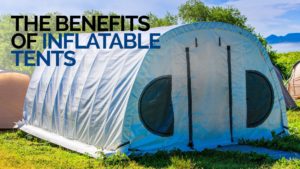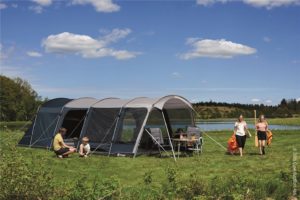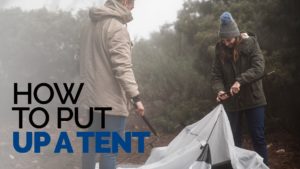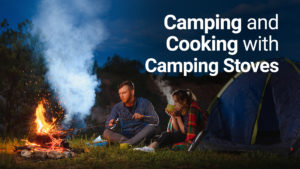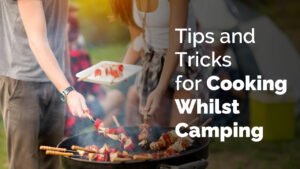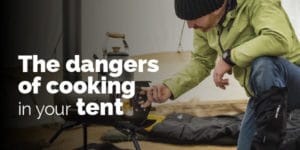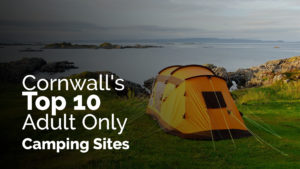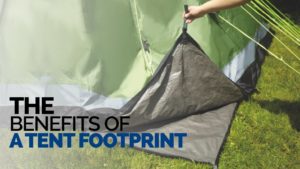
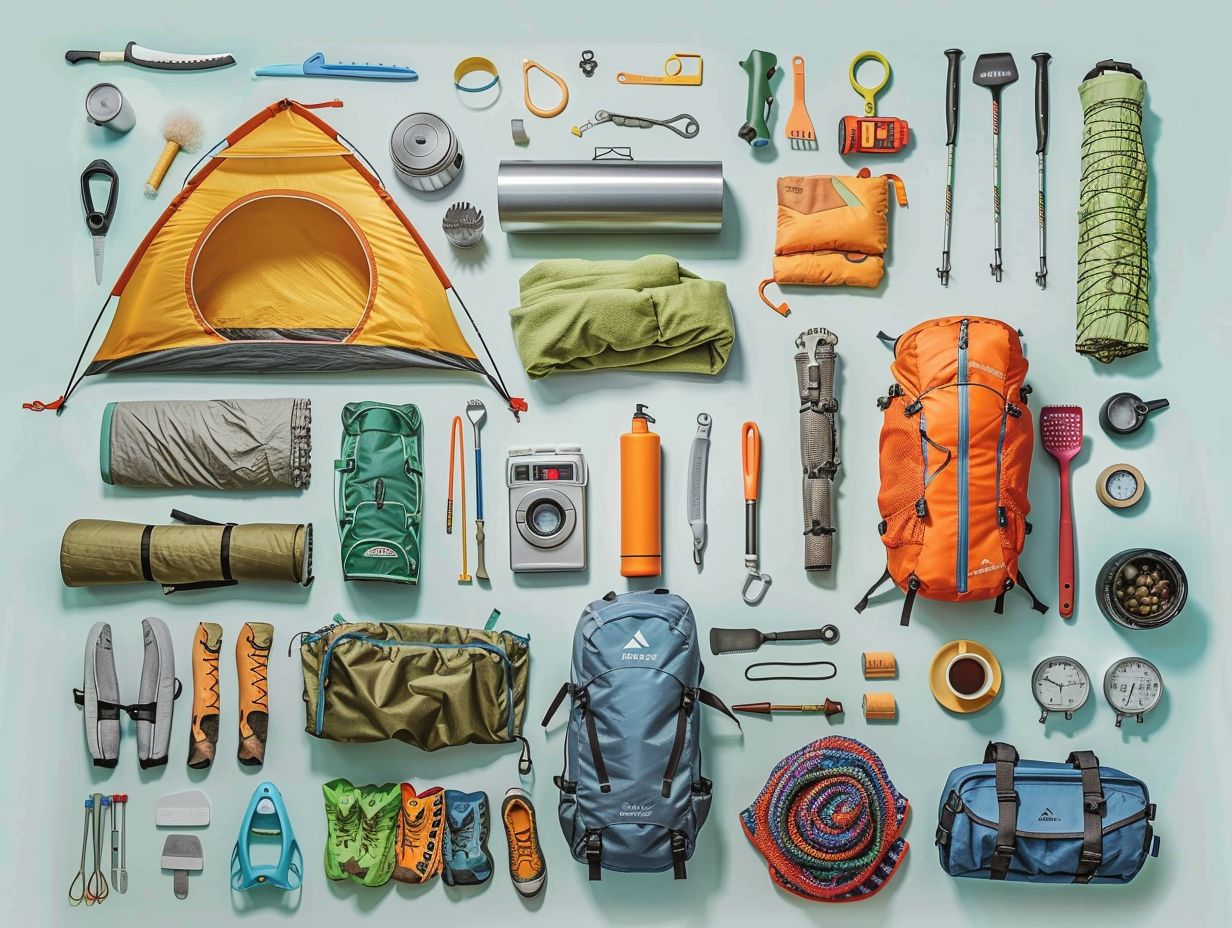
Vaibhav
- Categories: Advice
Are you tired of rummaging through your camping gear to find what you need? Organising your camping gear not only saves time but also reduces stress and maximises space.
We discuss the essential items for organising your gear, such as storage containers, labels, and a packing checklist. Tips on how to effectively organise your gear include sorting and grouping similar items, using storage containers, labelling everything, and creating a packing checklist.
Learn how to maintain an organised camping gear, including cleaning and drying gear before storage, re-evaluating and reorganising regularly, and keeping a master list of all your gear. Let’s get your camping gear organised for your next outdoor adventure!
Key Takeaways:

- Organizing camping gear saves time, reduces stress, and maximizes space.
- Essential items for organizing include storage containers, labels, and a packing checklist.
- To organize effectively, sort and group similar items, use storage containers, label everything, and create a packing checklist.
Why is it Important to Organize Camping Gear?
The organisation of camping gear is essential for facilitating a seamless and stress-free camping excursion. This practice enables individuals to optimise storage space, maintain the quality of outdoor equipment, and guarantee easy accessibility to all necessary items during the trip.
1. Saves Time
The organisation of camping gear serves as a time-saving strategy, facilitating the quick location of items during camping excursions. Efficient organisation not only expedites the retrieval of essential items but also optimises the overall camping setup process.
For instance, storing a sleeping bag meticulously in a designated compartment of the rucksack eliminates the need to search through all belongings when setting up for the night. Likewise, consolidating tent components within a labelled storage bag eradicates the inconvenience of locating individual pieces separately.
The systematic arrangement of cooking utensils in an easily accessible manner conserves valuable time during meal preparations, ensuring seamless and efficient camping experiences.
2. Reduces Stress
The proper organisation of camping gear serves to alleviate stress by ensuring that all necessary items, such as insect repellent and torches, are readily accessible. An orderly camping set-up not only reduces anxiety but also enhances mental clarity and efficiency during outdoor excursions.
For example, having essential tools like water bottles and penknives readily available in designated areas can prove crucial in emergency situations and contribute to a heightened sense of security. Maintaining a well-organised camp kitchen layout can streamline meal preparation, transforming it into a hassle-free and enjoyable endeavour.
By emphasising organisation in both your camping gear and set-up, you not only improve your outdoor experience but also cultivate a tranquil state of mind in the midst of nature’s splendour.
3. Maximises Space
Maximising space is a significant advantage of organising camping gear, a goal that can be attained through the utilisation of storage bins and wall panels.
The strategic use of storage solutions such as wall hooks, dry bags, and stuff sacks enables the effective arrangement of various items including hiking boots and mess kits. Wall hooks offer a practical method for hanging gear such as backpacks or jackets, thereby freeing up floor space within your vehicle or tent.
Dry bags are ideal for maintaining the dryness and compactness of clothing and essentials, while stuff sacks serve to compress bulky items like sleeping bags or tents, facilitating the conservation of space. These storage solutions not only promote efficient space utilisation but also ensure easy accessibility and systematic organisation of belongings throughout one’s camping excursions.
What Are the Essential Items for Organising Camping Gear?
In the realm of organising camping gear, having the suitable essential items is crucial to ensuring organised storage and convenient access.
1. Storage Containers
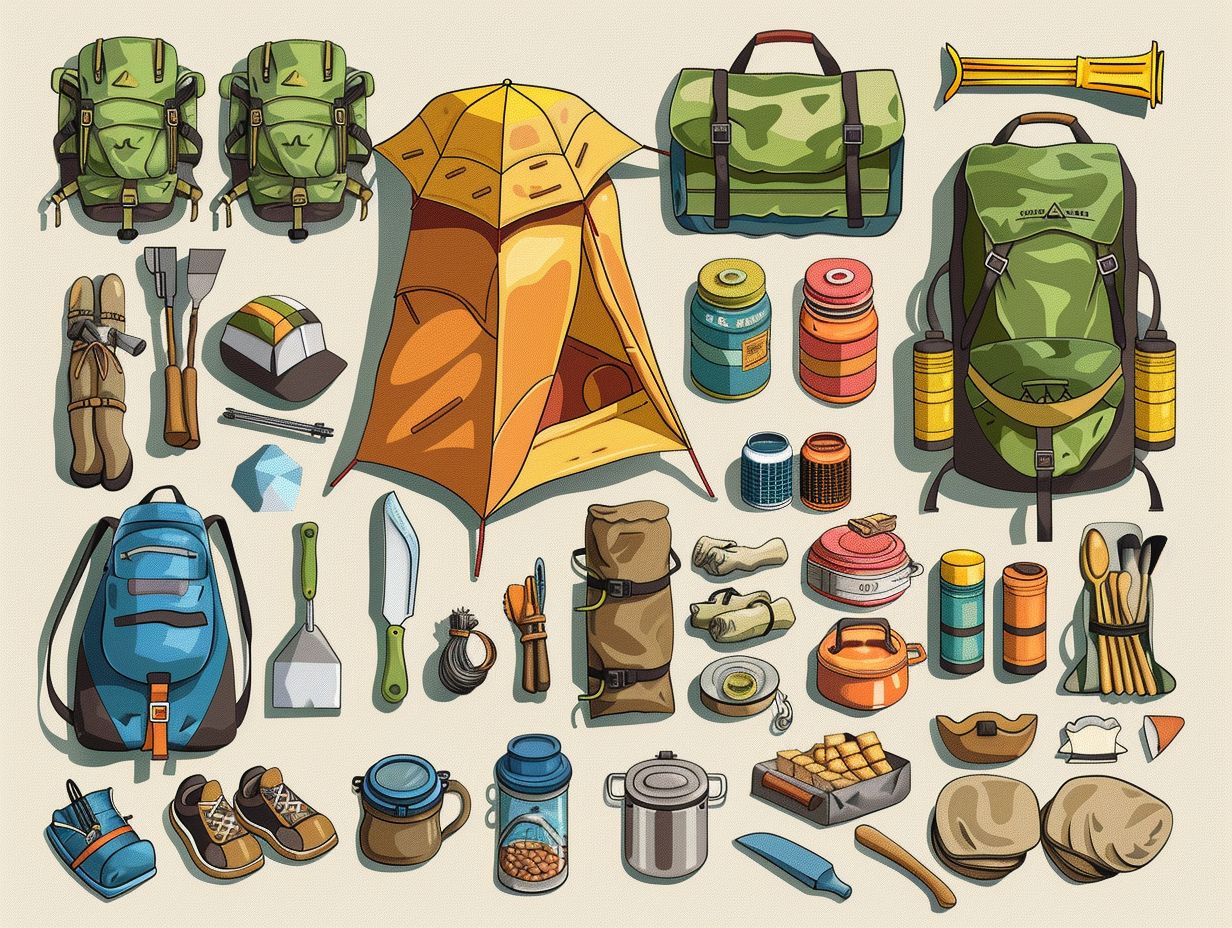
Storage containers, such as dry bags and pantry bins, are essential tools for maintaining the organisation and safeguarding of camping equipment from environmental hazards.
Dry bags are particularly valuable for safeguarding items that require protection against moisture, such as clothing, electronics, and important documents. Their impermeable composition guarantees the preservation of your possessions in dry conditions, rendering them essential for outdoor escapades.
Conversely, pantry bins prove advantageous for arranging camping provisions and pantry staples, facilitating orderly storage and ready accessibility. The integration of various storage containers enables the establishment of an effective storage framework that streamlines the camping endeavour.
2. Labels
Labels play a crucial role in establishing a personalised and organised camping setup, ensuring that all camping equipment is easily recognisable and readily accessible. When marking storage containers and gear, it is advisable to utilise clear and succinct descriptions that explicitly detail the contents.
For example, labelling a sleeping mat as ‘Large Self-Inflating Pad‘ can facilitate swift identification. Similarly, attaching labels such as ‘Filtered Water‘ or ‘Sports Drink‘ on water bottles can streamline the process of selecting the right one while on the move.
Furthermore, labelling hiking poles with their length or any distinctive features can help avoid confusion during group excursions. By dedicating time to creating effective labels, individuals can enhance the efficiency of their camping endeavours by optimising organisation and facilitating smoother logistical operations.
3. Packing Checklist
A packing checklist serves as an essential tool for organising camping gear and ensuring that all necessary items are accounted for prior to embarking on a camping trip.
Incorporating fundamental items such as mess kits, propane, and desiccant on the checklist can significantly enhance preparedness for outdoor excursions. Mess kits play a vital role in meal preparation, while propane serves as a dependable fuel source for cooking activities. Desiccant packs aid in moisture absorption, thereby maintaining gear dryness, particularly in humid conditions.
Through meticulous consideration of each item listed on the packing checklist, individuals can streamline packing processes and optimise efficiency in both gear storage and preparation.
How to Organise Your Camping Gear?
Effectively organising camping equipment involves:
- Categorising and consolidating similar items
- Using appropriate storage containers
- Clearly labelling all items
- Creating a comprehensive packing checklist to avoid any oversights
1. Sort and Group Similar Items
The initial step in arranging your camping equipment involves the sorting and grouping of similar items, such as tents, sleeping bags, and cooking utensils.
By categorising related items together – for instance, tarps and torches in a ‘lighting and shelter’ classification or cookware and utensils in a ‘kitchen essentials’ category – you can enhance accessibility and organisation.
This approach facilitates the efficient retrieval of necessary items during your camping excursion, eliminating the need to sift through a disarray of gear.
The creation of such categories not only streamlines the packing and unpacking processes but also minimises the risk of unintentionally leaving behind essential items. The systematic organisation of your gear can markedly enhance your overall camping experience.
2. Use Storage Containers
The utilisation of storage containers, such as laundry baskets and stuff sacks, is imperative for maintaining proper organisation and protection of camping gear.
Stuff sacks offer a specific benefit when it comes to storing sleeping pads, as they facilitate compressing the pads into a more compact size, thereby enhancing portability and transportability.
Conversely, dry bags serve as an effective means of shielding gear from moisture, particularly items like clothing or electronics, ensuring their preservation and dryness even in damp environments.
Moreover, clear plastic bins prove to be practical for storing smaller camping essentials like cooking utensils and toiletries. Their transparent nature enables easy visibility and accessibility to these items while navigating the wilderness.
3. Label Everything
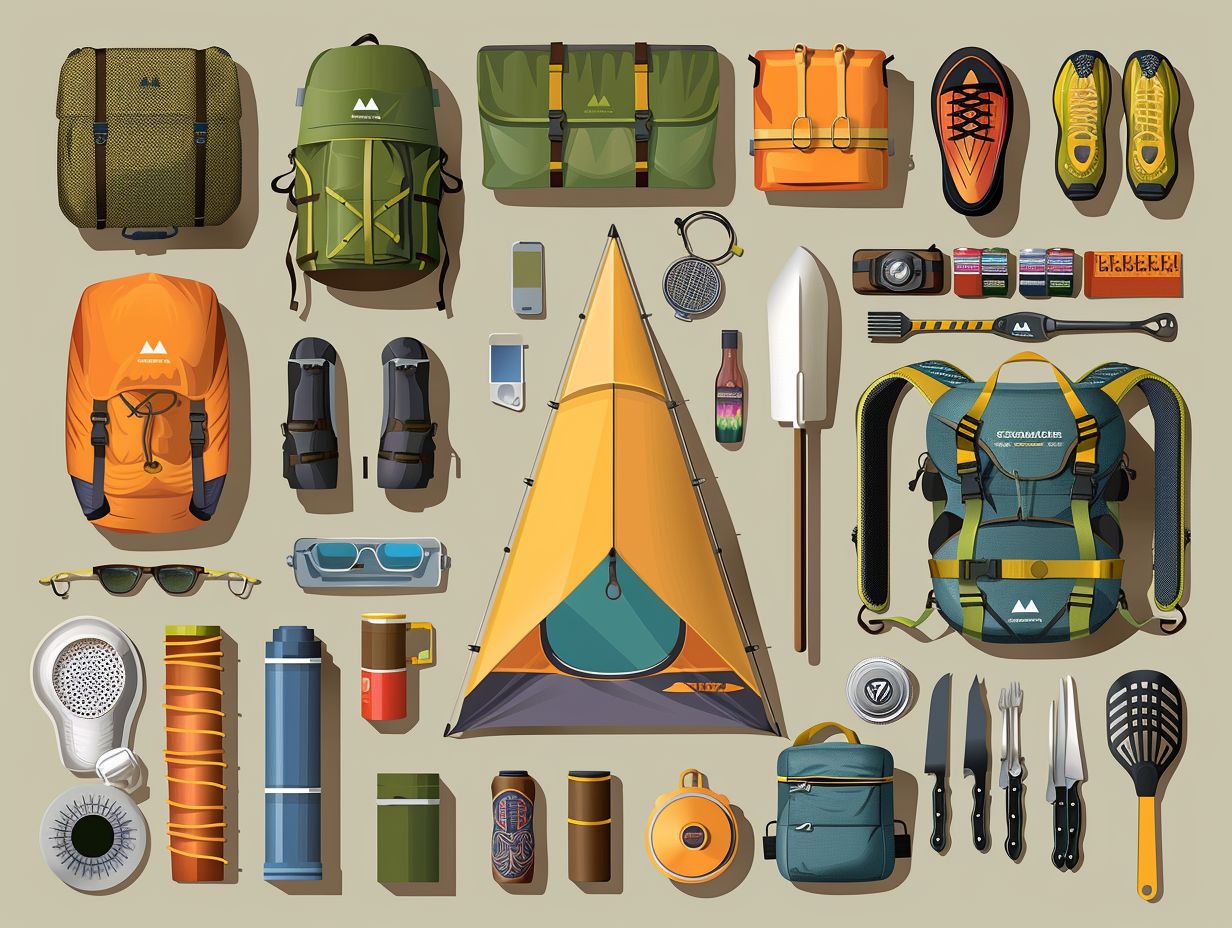
It is imperative to label all components of your camping gear set up to provide each item with a designated location and ensure ease of retrieval.
By incorporating clear and concise labels, the packing process is streamlined, eliminating the frustration associated with locating specific items. The utilisation of wall hooks can be highly beneficial in hanging labelled items such as utensils, pots, or keys.
The clear marking of each equipment piece not only saves time but also mitigates the risks of mix-ups and potential accidents.
In the organisation of cooking gear, labels play a vital role in distinguishing between various ingredients, utensils, and cookware. Similarly, the labelling of compartments within your hiking pack facilitates quick access to essential items like first aid supplies, navigation tools, and snacks.
4. Create a Packing Checklist
The development of a packing checklist is a critical component in the organisation of camping equipment and ensuring the presence of all necessary items for the camping expedition.
The inclusion of fundamental items such as water bottles, canteens, and hiking boots on the checklist is imperative for a successful camping undertaking.
Water bottles are essential tools for maintaining hydration levels, particularly during hikes or other outdoor activities. Canteens offer a convenient means of transporting larger quantities of water for extended journeys.
High-quality hiking boots are essential for safeguarding the feet and ensuring comfort during prolonged walks or hikes across diverse terrains.
By methodically ticking off these items on the checklist, individuals can relax and relish their camping experience with a sense of assurance.
Tips for Maintaining an Organised Camping Gear
To maintain an orderly camping equipment arrangement, regular maintenance is essential. This involves cleaning and drying equipment before storage, periodically reassessing and reorganising, and keeping a comprehensive master list of all equipment.
1. Clean and Dry Gear Before Storage
It is imperative to clean and dry your gear before storing it to prevent damage and ensure protection from moisture. Properly cleaning and drying items such as sleeping bags and hiking boots can prolong their lifespan and enhance their performance during your next outdoor excursion.
To prevent mildew and odours, it is advisable to thoroughly air out sleeping bags before storage. Likewise, hiking boots should be cleaned of any dirt and debris and then dried meticulously to prevent the development of mould and bacteria.
Consistent maintenance of your gear will not only result in long-term cost savings but also lead to a more comfortable and enjoyable outdoor experience.
2. Reassess and Reorganise on a Regular Basis
Regularly reassessing and reorganising one’s camping gear is essential in maintaining an efficient and updated setup. Through periodic evaluations of the gear, individuals can verify the presence of all essential items for their camping excursions while eliminating unnecessary items that occupy space.
For example, following a recent camping trip wherein certain items were not utilised, adjustments can be made to the packing checklist accordingly. Reorganising storage bins in alignment with recent camping experiences facilitates easier item retrieval, thereby saving time and reducing frustration during campsite setup.
3. Keep a Master List of All Gear
The practice of maintaining a comprehensive master list of all camping gear is essential for upholding an organised camp setup and preventing any oversights.
This master list functions as a detailed inventory of your camping equipment, encompassing items such as cooking gear, hiking packs, and provisions for camping meals.
By classifying these items according to their purpose, it becomes simpler to discern the necessary elements for each excursion. It is imperative to prioritise crucial items like a durable tent, sleeping bags, and cooking utensils.
It is advisable to routinely review and update your inventory by eliminating worn-out gear and incorporating new essentials to accommodate evolving requirements. This method not only facilitates efficient packing procedures but also guarantees that you are adequately equipped for any outdoor venture.
Frequently Asked Questions
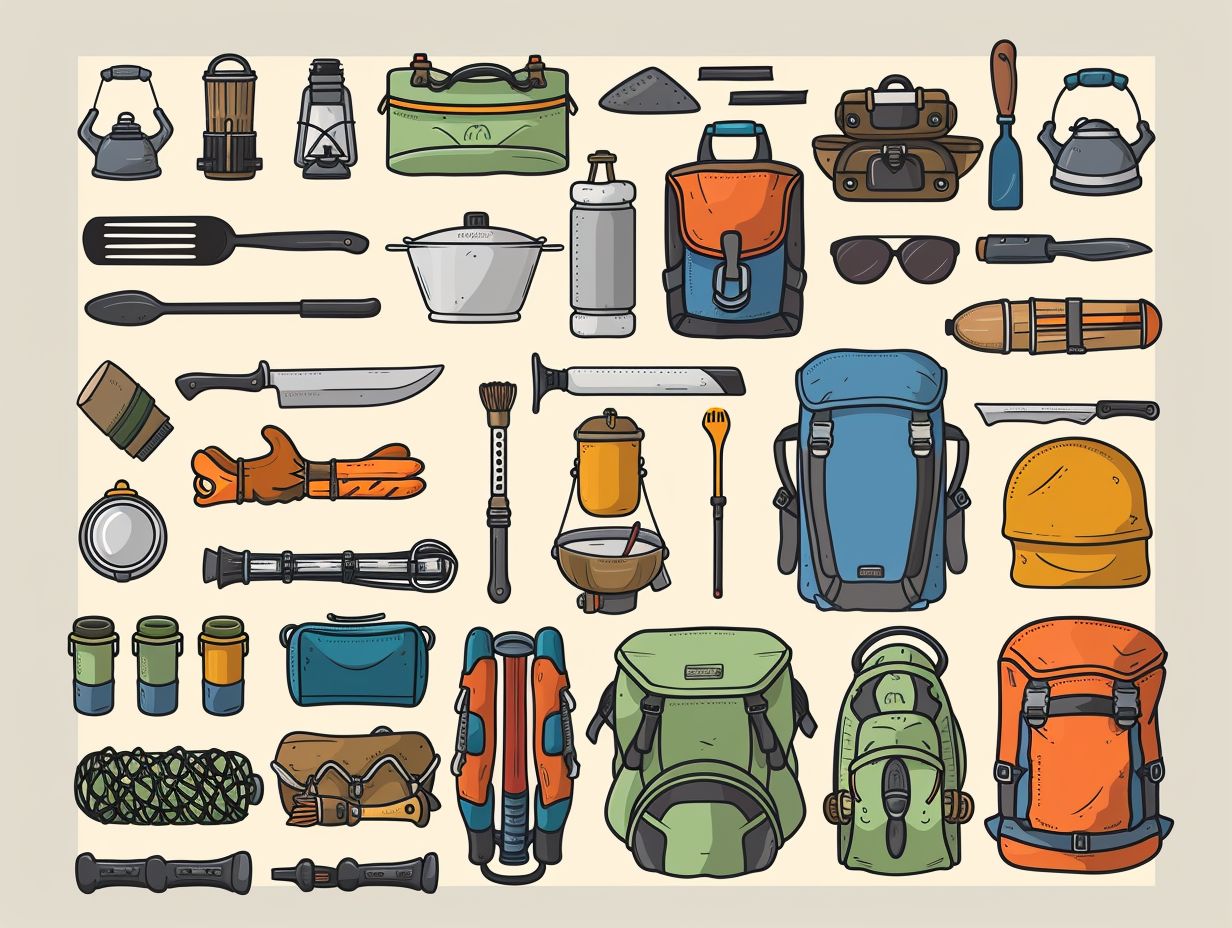
What are some tips for organizing your camping gear?
1. Create a checklist: Before you start packing, make a list of all the essential items you will need for your camping trip. This will help you stay organized and ensure you don’t forget anything.
2. Use storage bins: Invest in storage bins or containers to keep your gear organized and easily accessible. Label them with the contents for easy identification.
3. Pack according to frequency of use: Pack frequently used items in a separate bag or on top for easy access, and less frequently used items at the bottom or in less accessible areas.
4. Roll instead of fold: Instead of folding clothes and towels, roll them up. This not only saves space but also prevents wrinkles.
5. Utilise the inside of your tent: Use the inside of your tent to store smaller items like flashlights, bug spray, and toiletries. This will keep them within reach and prevent them from getting lost.
6. Keep a designated “dirty” bag: Have a separate bag or bin to store dirty or wet items, such as muddy shoes or wet towels, to keep them from mixing with clean gear.
How can I make sure my camping gear stays organised during the trip?
1. Have designated spaces for each item: Assign a specific spot for each item in your gear, and make sure to put it back in its designated spot after use.
2. Use packing cubes: Packing cubes are great for keeping clothes and smaller items organised within your bag or backpack.
3. Keep things compact: Use compression bags or straps to make your gear more compact and save space.
4. Use carabiners: Attach carabiners to your backpack or bag to hang smaller items like keys, water bottles, or hats.
5. Have a clean-up routine: Set aside a few minutes each day to tidy up and put things back in their designated spots to prevent clutter from building up.
6. Regularly reorganise: Take a few minutes every couple of days to reorganise your gear and make sure everything is in its proper place.
What should I consider when organising my camping gear for a multi-day trip?
1. Divide gear by days: If you’re going on a multi-day trip, divide your gear into separate bags or containers for each day. This will make it easier to find what you need without unpacking everything.
2. Use dry bags: Invest in dry bags to store clothes and other items that need to stay dry, especially if you’ll be near water or in rainy conditions.
3. Pack light: Avoid overpacking by only bringing what you need. This will not only make your gear more organised but also save you from carrying unnecessary weight.
4. Prioritise essential items: Make sure to pack essential items like a first aid kit, water, and food in easily accessible places.
5. Don’t forget extra space: Leave some extra space in your bag for souvenirs or items you may need to bring back with you.
6. Keep a separate “dirty” bag: To avoid mixing dirty and clean items, have a designated bag or compartment for dirty or wet gear.
What can I do to prevent my camping gear from getting lost or mixed up?
1. Label everything: Use labels or permanent markers to mark your gear with your name or initials. This will make it easier to identify your items if they get mixed up with others.
2. Have a system: Develop a system for storing and organising your gear, and stick to it. This will prevent things from getting misplaced or lost.
3. Keep important items close: Keep important items like your phone, wallet, and keys in a designated, easily accessible spot.
4. Use bright colours: Choose gear in bright colours or patterns to make them stand out and easier to spot if they get misplaced.
5. Keep a checklist: Keep a list of all your gear and check it before leaving your campsite to ensure you don’t leave anything behind.
6. Store items in clear bags: Use clear, plastic bags to store smaller items in your gear. This will make it easier to find them and prevent them from getting lost in larger bags.
How can I pack efficiently and save space when organising my camping gear?
1. Use packing cubes or bags: Packing cubes or bags can help you save space and keep your gear organised and compact.
2. Roll instead of fold: As mentioned earlier, rolling clothes instead of folding them can save a lot of space in your bag.
3. Pack multipurpose items: Choose gear that can serve multiple purposes, such as a scarf that can also be used as a towel or a flashlight that can double as a lantern.
4. Use the “fill the gaps” method: When packing your bag or car, use smaller items to fill in any gaps or empty spaces to maximise space.
5. Don’t bring duplicates: Avoid bringing duplicate items, such as multiple pairs of shoes or similar clothing items, to save space and prevent unnecessary clutter.
6. Use compression bags: Compression bags are great for saving space and keeping clothes or sleeping bags compressed and compact.
What should I do with my camping gear when I return from my trip?
1. Clean and dry everything: Before storing your gear, make sure to clean and dry everything thoroughly to prevent mould or mildew from forming.
2. Reorganise: Take a few minutes to reorganise your gear and make sure everything is in its designated spot.
3. Wash any dirty bags: If you used any bags or containers to store dirty or wet items, be sure to wash and dry them before storing them away.
4. Repack your bag or bin: Repack your bag or bin according to your checklist or system to make it easier for the next trip.
5. Store in a dry, cool place: Storing your gear in a dry, cool place will prevent any damage or wear and tear from heat or moisture.
6. Make a note of any missing items: If you notice any missing or damaged items, make a note of them so you can replace or repair them before your next trip.
Share:
By submitting your email address, you are agreeing to receive marketing emails from theexpertcamper.co.uk.
We’ll never share your email address and you can unsubscribe at any time. Privacy policy
Related Posts

A Seasonal Guide To Hiking In The Peak District
Are you ready to lace up your hiking boots and explore the stunning landscapes of the Peak District? This seasonal guide will take you through

Hiking Challenges Preparing For Your First Ultrahike
Are you ready to take your hiking adventures to the next level? Ultra-hiking offers a unique combination of physical and mental challenges, breathtaking scenery, and
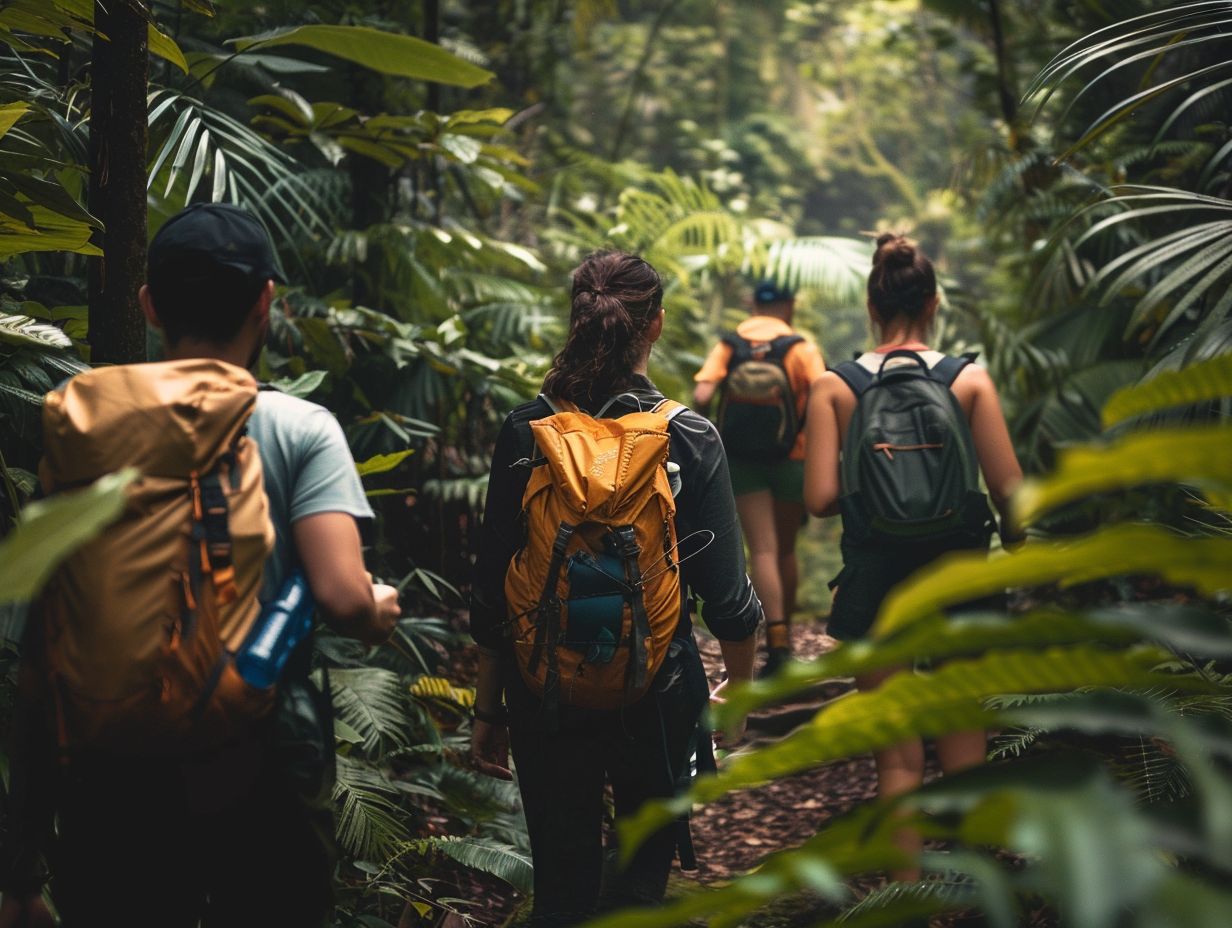
Ecofriendly Hiking Tips For Sustainable Adventures
Are you an outdoor enthusiast looking to minimise your impact on the environment while enjoying the great outdoors? Eco-friendly hiking is the perfect solution! We

The Best Hiking Trails For Experiencing UK Wildlife
When exploring the picturesque hiking trails of the UK, you can expect to encounter a diverse array of wildlife. From majestic birds soaring overhead to

Wildflower Walks The Best Trails For Nature Lovers
Are you a nature lover looking to embark on a wildflower walk? Explore the best trails for wildflower walks, including [Trail Name 1], [Trail Name


